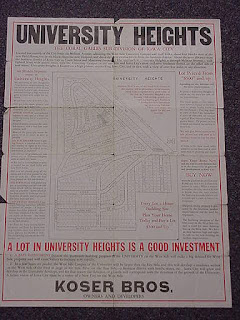Here is the text from my favorite portion, which is on the side not pictured above. It's a mixture of facts, hype and a dash of greed thrown in for good measure:
WEST SIDE REAL ESTATE
West Side real estate now offers the best opportunity for good investment since the beginning of Iowa City. The immediate building program of the University on the West Side is almost equal to the amount of buildings done by the University on the East Side during the past fifty years. The resale value of Real Estate on the West Side has been as high as 300 to 400 per cent. (this does not however include buildings, because their value is governed by cost of labor and material.) On March 1, 1918 we purchased an acre of ground from the Cannon estate for about $2,000. 1921 we sold this acre for $4,000, and last year this acre was divided into lots and sold for a total amoun of around $14,000. About 12 years ago Byington's Addition was laid out, covering the ground now occupied by the Quadrangle and new Field House. Lots were offered for $300 to $500. Only a few lots were sold until the University purchased the land for $5,000. Today a lot would be worth $5,000 or more. Around 1920 we were offered the land now covering Melrose Circle for $5,000. Today, this land, now divided nto lots could not be purchased for less than $23,000. About ten years ago we sold a lot on Melrose Avenue and South Grand Avenue for $800. Two years ago the University paid around $5,500 for this lot. In the year 1921 we were selling lots on Melrose Avenue for $700 to $800 that are now priced around $4,000 and $5,000. On March 1, 1916 we sold thirty acres of the land now a part of University Heights, for $350 per acre, and in 1923 ---only seven years afterwards--- we purchased it back at $1,000 per acre. Many other illustrations could be given of the wonderful increase in value of property along Melrose Avenue, and yet the building program of the Univerity on the West Side has just started. It is now too late to buy lots close in on Melrose Avenue for $700 or $800---the time was 1920. Now is the time to buy lots on Melrose Avenue in University Heights to sell in 1930. Unless you buy you cannot sell. Unless you take some chance you cannot reap the profits. The building program of the University on the West Side is assured and for that reason an investment in Rest Estate on the West Side near University Campus must increase in value.
The football stadium is currently undergoing an $89 million dollar renovation, and an undeveloped chunk of ravine between Iowa City and University Heights sold last year and is going to be developed into sports condos starting at $200K.
 Here is a record of our restoration of a 1928 craftsman. We will be the second family to live in the home. Watch our progress when we prevail and our privation and pratfalls as we do not.
Here is a record of our restoration of a 1928 craftsman. We will be the second family to live in the home. Watch our progress when we prevail and our privation and pratfalls as we do not.



1 comment:
Very cool discovery!
Post a Comment